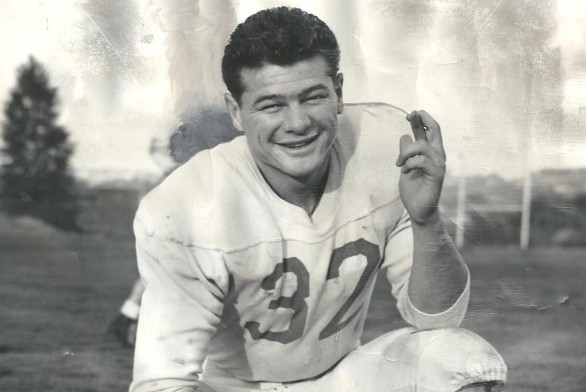
By David Eskenazi and Steve Rudman
Sixty years ago this month (Oct. 6, 1951) the 12th-ranked Southern California Trojans recorded a 20-13 victory over Washington in front of 43,747 fans at Husky Stadium. Nothing unusual in that (especially in that era of Husky football) except that UW fans, ignoring USCs poll stature, fully expected an upset. A light shower only enhanced the local enthusiasm.
But USC never trailed. The Trojans assumed a 7-0 lead on a Leon Sellers two-yard run in the first quarter. The Huskies answered with a 38-yard touchdown pass from backup quarterback Dean Rockey (starter Sam Mitchell exited early with an injury, as did UWs fastest player, Dick Sprague), but USC scored just before halftime, Jim Sears plunging in from two yards.
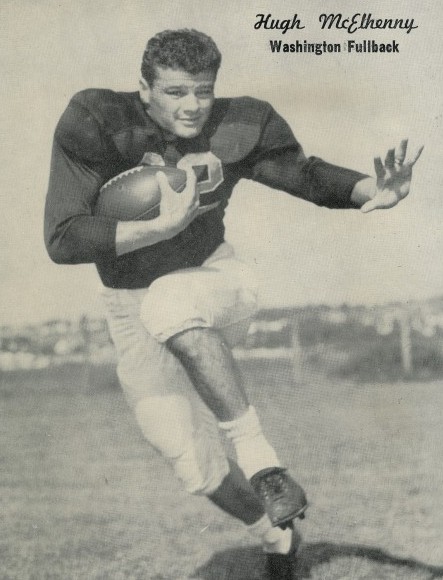
USC entered the fourth quarter with a 13-7 lead (Trojan All-America Frank Gifford missed the PAT following the Sears touchdown) and continued to threaten with a passing attack that caught the Huskies flat-footed time after time.
With five minutes gone in the quarter, Washington forced the Trojans to punt. Normally, Gifford handled that chore, but first-year head coach Jess Hill sent in Des Koch, a sophomore from Shelton, WA., instead because of the short field: the line of scrimmage was the 50-yard line. The play, as it started to unfold:
——————–
Koch retreated to punt and Hugh McElhenny of Washington stationed himself in the center of the field, his back foot almost on the goal line. McElhenny received orders from UW head coach Howie Odell not to field the punt just let it go.
Koch aimed his punt for the right sideline, but didnt get the kick he wanted. Instead of angling toward the sideline, the ball came almost straight to McElhenny, who only had to drift a couple of yards to his right.
Odell sensed immediately that McElhenny would catch the punt, despite his orders to the contrary. Alarmed, Odell raced down the sideline, imploring McElhenny not to catch it.
Let it go! Let it go! Odell screamed.
But McElhenny, overcome with an instinct only the greatest running backs possess, had become oblivious to the ranting head coach.
——————————————————-
McElhenny established dozens of rushing, all-purpose and scoring records during his three varsity seasons (1949-51) at Washington, 16 alone in rushing, some of which stand despite the various onslaughts of Junior Coffey, Joe Steele, Greg Lewis, Napoleon Kaufman, Rashan Shehee, Corey Dillon, Louis Rankin and, most recently, Chris Polk.
McElhennys most famous mark and his most memorable performance occurred on Nov. 25, 1950, when he ran for 296 yards and five touchdowns in a 52-21 victory over Washington State. In the 60 seasons since, no other UW back has come within 12 yards of that mark (Polk had 284 against Washington State in 2010).
McElhenny accumulated those 296 yards and five TDs on just 20 carries for an average of 14.8 yards per attempt an NCAA record at the time and still Washingtons single-game standard (when Dillon, the 1996 one-year wonder, ran for 222 yards against San Jose State in one quarter, he averaged 13.9 yards per attempt; Polk against WSU in 2010 averaged 9.8 yards per attempt).
When McElhenny finished the 1950 season with 1,107 yards, he became the first player in the first 61 years of Washington football to exceed 1,000 yards in one season. It took 26 years for the Huskies to feature another 1,000-yard rusher, Ronnie Rowland in 1976 (1,002).
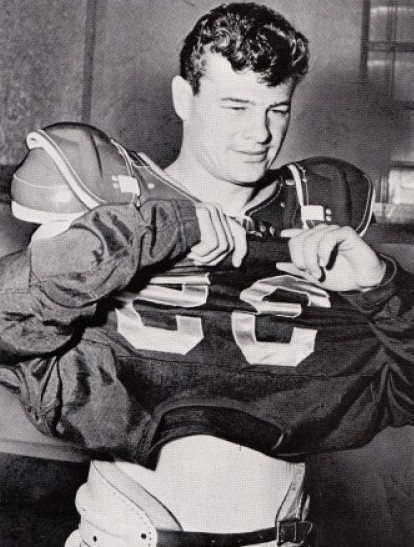
McElhenny ended his UW career with 2,499 rushing yards, which stood as the school standard for 28 years. Steele broke it in 1979 after having played in 39 career games. McElhenny saw action in 28.
During the 1950 season, McElhenny scored 125 points, breaking Chuck Carrolls single-season record of 104, set in 1928. That McElhenny record lasted until 1996 when Dillon tallied 150 in 12 games. McElhenny scored 125 in 10 games, so they each averaged 12.50 points per game, still the school record.
McElhenny scored an average of 8.32 points per game during his 28 Husky contests. In 39 games, No. 2 Steele scored 5.74 points per game. No. 3 Shehee (1994-97) averaged 5.45 (they are the only non-kickers in UW annals to average more than five points per game.
During his career, McElhenny rushed for an average 89.3 yards per game. It took 43 years for another Husky back, Kaufman (1991-94), to match that record.
————————————————-
McElhenny caught the ball exactly at the goal line, recalled Gifford, who was on the field for the punt return, and then he started to zig down the field.
Meanwhile, Odell reached the five-yard line, but was too late. As McElhenny flashed past him, Odell grimaced and slapped himself upside the head as the Husky Stadium crowd rose to its feet.
————————————————-
While the numbers McElhenny amassed speak to his intuitive genius of carrying a football, they fail at capturing the essence of his ability: He was, according to the collective testimony of all who saw him, your wildest football imagination come to life. At 6-1 and 205 pounds, he could leave far lighter tacklers riveted in their tracks.
He was the kind of runner who could make more magic, write more stories and paint bigger pictures in the span of five yards than practically anybody else could do in 30, 40 or 50 yards.
McElhenny just didnt cause mass gawks, he made a crowds collective blood pressure spike. By the time McElhennys career finished, it was widely acknowledged that only Red Grange had made open-field running such a spectacle.
John Jarstad served as the radio voice of the Huskies when McElhenny and quarterback Don Heinrich headlined Howie Odells Flying Circus.
I know everything that was written about him, Jarstad once said. And none of it was adequate. Hugh was always doing the impossible. Up there in the broadcast booth, I kept wondering what he could do for an encore. He drove tacklers batty.
“The idea that Hugh was a great runner because of how hard he practiced was garbage. He was a free spirit, often goofed off during the week and was called on the carpet. What he did on Saturday wasnt taught. It came straight down from heaven.
After McElhenny cracked the starting lineup of the San Francisco 49ers as a rookie in 1952, the league began to find out what Husky fans had been privy to during his three seasons at Montlake. In fact, McElhenny had just joined the Niners after playing in the College All-Star Game, and was standing on the sidelines during a preseason contest.
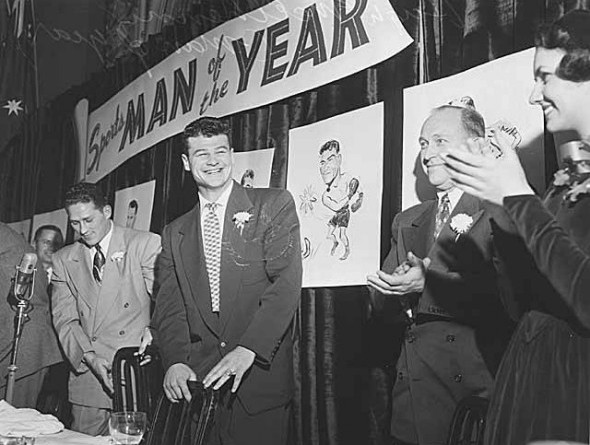
Frankie Albert (the left-handed Stanford graduate is credited with inventing the bootleg play), the San Francisco quarterback, yelled over at coach Buck Shaw, Send in McElhenny (in 1960, coaching the Philadelphia Eagles, Shaw became the only coach ever to beat Vince Lombardi in an NFL Championship Game).
Shaw shook his head and yelled back, He doesnt know the plays.
Since when, Albert snapped, do we let something like that bother us?
So Shaw sent in McElhenny. Albert improvised a play on the palm of his hand. Then he looked at McElhenny.
Well call this 27 toss, said Albert. Ill pitch the ball to you, and you take it from there.
McElhenny took it 40 yards to a touchdown on his first professional carry. He went on to have a number of such runs (McElhenny scored 60 NFL touchdowns — 38 rushing, 20 receiving, two punt returns — of which 17 covered 30 or more yards). McElhenny’s NFL scoring plays of at least 50 yards:
| Year | Date | Opponent | Play | Distance |
|---|---|---|---|---|
| 1952 | Oct. 19 | Bears | Punt return | 94 |
| 1952 | Oct. 5 | Texans | Run from scrimmage | 89 |
| 1956 | Nov. 18 | Packers | Run from scrimmage | 86 |
| 1952 | Oct. 26 | Texans | Run from scrimmage | 83 |
| 1961 | Dec. 17 | Bears | Punt Return | 81 |
| 1959 | Nov. 1 | Lions | Pass from Y.A. Tittle | 62 |
| 1954 | Oct. 24 | Lions | Run from scrimmage | 60 |
| 1958 | Oct. 19 | Eagles | Pass from John Brodie | 59 |
| 1955 | Nov. 6 | Rams | Pass from Y.A. Tittle | 55 |
| 1956 | Oct. 28 | Bears | Run from scrimmage | 51 |
Three years earlier, in his first varsity game at Washington, McElhenny broke the school single-game (regular season) rushing record by collecting 105 yards against Utah. A year later, in the 1950 opener against Kansas State, he rushed for 177, including 91 for a TD. It marked one of the great performances in Husky history and was the subject of conversation throughout McElhennys tenure at the university (the previous single-game high had been 134 yards by George Wilson against Alabama in the 1926 Rose Bowl).
But it was also so typical of McElhennys ability that, when asked to recall that 177-yard performance in advance of the UW football centennial in 1990, he drew an all-in-a-day’s-work blank.
I dont even remember that game, he said.
———————————————-
McElhenny didnt quite know where he was. He thought he was near the five. In fact, he was at the very right corner of the field when he caught Kochs punt.
As I remember it, said McElhenny, we were down 14-0 (actually 13-7) and nothing was happening. And so I said to myself that it was time to make something happen. I didnt really realize I was on the goal line. I thought I was between the five and the 10. It was probably stupid, but its just sort of a runners feeling that you go for it.”
————————————————-
No McElhenny record speaks to his versatility more than this one: In three seasons, McElhenny rushed for 2,499 yards, caught passes for 760, returned punts for 228 and brought back kickoffs for 747 for a total of 4,234, an average of 151.2.
The next-best all-purpose mark in Washington history is 126.8 by Kaufman between 1991-84. Steele ranks third at 107.7. No other player in school history averaged 100.0.
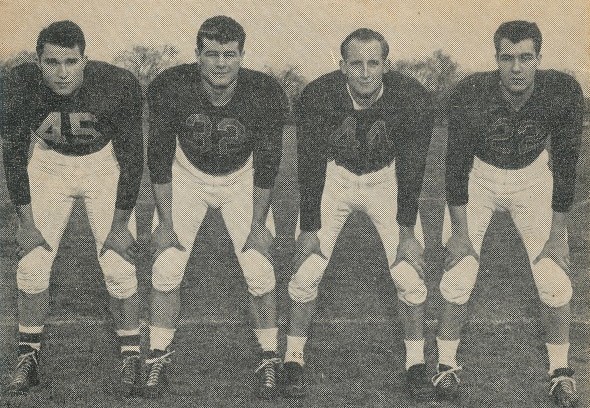
Remarkable as is McElhennys career average, throw out his sophomore year of 1949 and his numbers become staggering. In 1951, McElhenny averaged 167.8 yards per game. In 1950, he averaged 164.4. Kaufman didnt break McElhennys 167.8 record until 1993, when he averaged 168.3 (Louis Rankin holds the mark at 184.3).
McElhennys 1950 and 1951 totals still rank seventh and eighth on the career list 60 years after he compiled them, which is more of a testimony to McElhenny than to the parade of outstanding runners who followed him.
—————————————————–
McElhenny left the first USC tackler on his face, but soon found himself pinned in by three other Trojans against the sidelines.
I made a couple of moves and started up the sidelines, said McElhenny. Frank (Gifford), I think, was kind of caught off balance because he didnt think I was going to catch the ball, and also that I would be caught. It left him out of position to cover the punt.
After getting rid of the first tackler, McElhenny shook off two more and found himself suddenly out of the hole. By the time he arrived at the 35, only Gifford stood between him and the goal line.
Frank stretched out his arm, said McElhenny. He didnt figure I would get that far.
—————————————————-
McElhenny still co-holds the UW record for most 50-yard runs in a season with three (1950), and ranks fourth on the career list with four. When McElhenny averaged 6.2 yards per attempt in 1950, that stood as Washingtons record until 1997 when Shehee eclipsed it by averaging 6.3 (Kauffman averaged 6.0, 5.7 and 5.5 yards per attempt in his three seasons with the Huskies).
Washington teammate Don Heinrich, who played and coached professionally for many years, once said of McElhenny: He was unquestionably a totally superior athlete. His running ability was as good as any player who ever lived. His peripheral vision was much like O.J. Simpsons. I dont know of a player you could call better.
Hall of Famer Ernie Nevers (1902-76), who admittedly never saw the likes of, say, Barry Sanders, but did watch Jim Brown, said, The only guy who has come close to his speed, balance and elusiveness is Gale Sayers.
Said Billy Wilson, who played with McElhenny in San Francisco: He could change his course two and three times in one run. He was unbelievable.
Added Frankie Albert: McElhenny was like a bowling ball thrown with body English, It slides crazily down the alley, curls around the pins and scatters them gently.
Said former NFL quarterback Y.A. Tittle: Mac was the greatest broken-field runner football has ever seen.
———————————————-
By the time he arrived at his own 35, McEhenny had clear sailing. By the time he reached the 50-yard line, most of the Trojans had given up any hope of catching him.
Suddenly, said Gifford, there was only one man between him and the goal line me.
And Gifford knew exactly what was going to happen.
He left me flat on my face, recalled Gifford, and ran 100 yards for the touchdown.
————————————————–
The previous Washington record for longest punt return had been 85 yards, by Johnny Cherberg, who would go on to coach the Huskies from 1953-55, at Stanford in 1932.
I probably had as many touchdowns called back as I made, McElhenny once said. Sometimes Id run 60 yards to make 10. I dont know if it was because I was so damned scared, or I didnt have an offensive line. But seriously, you dont gain the kind of yards I did without a team in front of you. But the way I ran, it was difficult for my blockers to keep from clipping.
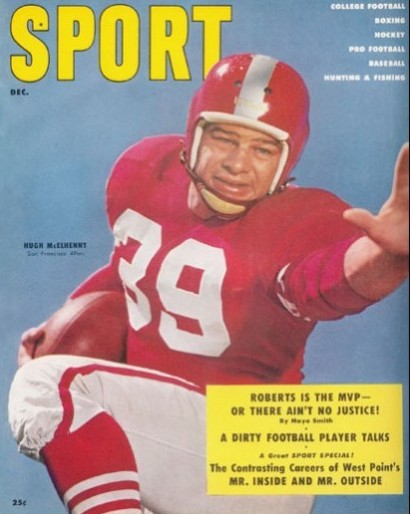
McElhennys 100-yard punt return completed another, although unofficial, record. With it, McElhenny became the first and still the only player in school history with three 90-yard scoring plays.
First, a 96-yard kickoff return TD against Minnesota in 1949, then a 91-yard TD run from scrimmage against Kansas State in 1950, and finally the 100-yard punt return against USC in 1951, 60 years ago this month.
McElhenny is the only Husky — running back or otherwise –enshrined in the Pro Football Hall of Fame (1970) and National Football Foundation College Hall of Fame (1981).
“He was the darndest animal,” former UCLA coach Red Sanders said. “He ran around you, through you and, if the situation demanded it, right over you.”
————————————————
Check out David Eskenazis Wayback Machine Archive. David can be reached at (206) 441-1900, or at seattlesportshistory@gmail.com

2 Comments
This is the best single piece ever written on Hugh McElhenny. As an 11-year old, my father and I drove from our small eastern Washington town to watch his last game as a Husky. It was the 27-25 Washington State victory which featured McElhenny nearly running a kickoff back for a touchdown, only to be caught inside the 10-yard line when he made one cutback too many. To see Hugh McElhenny in person and to watch him run in person was one of the greatest sports thrills of my life. The years before my parents attended the Washington-Washington State game in Spokane. They didn’t take me along and, as it turned out with McElhenny’s 296 yards rushing and five touchdowns, it was the one game I’ve always wished I could have seen because there was no TV in those days.
This is the best single piece ever written on Hugh McElhenny. As an 11-year old, my father and I drove from our small eastern Washington town to watch his last game as a Husky. It was the 27-25 Washington State victory which featured McElhenny nearly running a kickoff back for a touchdown, only to be caught inside the 10-yard line when he made one cutback too many. To see Hugh McElhenny in person and to watch him run in person was one of the greatest sports thrills of my life. The years before my parents attended the Washington-Washington State game in Spokane. They didn’t take me along and, as it turned out with McElhenny’s 296 yards rushing and five touchdowns, it was the one game I’ve always wished I could have seen because there was no TV in those days.